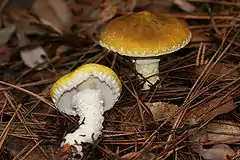Floccularia albolanaripes
Floccularia albolanaripes is a species of fungus in the family Agaricaceae. Mushrooms are characterized by their yellow caps with a brownish center and scales over the margin, and the conspicuous remains of a partial veil that is left on the stipe. The species grows in the Pacific Northwest and the Rocky Mountains of North America, and in India.
| Floccularia albolanaripes | |
|---|---|
 | |
| Scientific classification | |
| Kingdom: | |
| Division: | |
| Class: | |
| Order: | |
| Family: | |
| Genus: | |
| Species: | F. albolanaripes |
| Binomial name | |
| Floccularia albolanaripes (G.F.Atk.) Redhead (1987) | |
| Synonyms[1] | |
|
Armillaria albolanaripes G.F.Atk. (1908) | |
Taxonomy
The species was first described as Armillaria albolanaripes by American mycologist George F. Atkinson in 1908. The type specimens were collected from Corvallis, Oregon on November 6, 1906.[2] It was known as an Armillaria for several decades until members of that genus with amyloid spores and lacking black rhizomorphs were transferred to Floccularia in 1987.[3]
Description
The cap is convex to flattened (sometimes with a shallow umbo), measuring 5–12 cm (2.0–4.7 in) in diameter. Its color is bright-yellow to orange-yellow and then later brownish, and it has flattened brownish scales over the center. The whitish cap margin is rolled inward. The well-separated gills have tooth-like edges, and an adnate attachment to the stipe, sometimes with a notch. They are initially white before turning cream in maturity. The stipe measures 3–8 cm (1.2–3.1 in) long by 1–2.5 cm (0.4–1.0 in) wide, and is roughly the same width throughout. Shiny with a light yellow-brown base color, it has one to several cottony zones of partial veil remnants. The flesh is firm, and white to yellow under the cap cuticle. It has no distinguishable odor and a mild taste.[4] F. albolanaripes mushrooms are edible.[5]
The spore print is white. Spores are ellipsoid, smooth, and measure 6–8 by 4–4.5 µm.[6]
Similar species
The base form of species Floccularia luteovirens is similar in appearance, but can be distinguished from F. albolanaripes by its brighter yellow cap color with raised scales on the surface, and yellowish gills.[7] F. luteovirens forma straminea (which has sometimes been defined as a distinct species, F. straminea) is another lookalike with similar coloration and habitat preferences, but its cap features shaggy scales arranged in concentric zones, and it has light yellow gills.[8][9][10]
Habitat and distribution
The fruit bodies of Foccularia albolanaripes grow singly to scattered under conifers. In North America, it is found in the Pacific Northwest and the Rocky Mountains, where it occurs in the spring and summer.[4] A snowbank mushroom, it is often found around the edge of melting snowbanks, or shortly after the snow has melted.[11] In Kashmir, India, it grows in a suspected mycorrhizal association with Pinus wallichiana.[12]
References
- "Floccularia albolanaripes (G.F. Atk.) Redhead, Canadian Journal of Botany, 65(8):1556, 1987". MycoBank. International Mycological Association. Retrieved 2013-09-12.
- Atkinson GF. (1908). "Notes on some new species of fungi from the United States". Annales Mycologici. 6 (6): 54–62.
- Redhead SA. (1987). "The Xerulaceae (Basidiomycetes), a family with sarcodimitic tissues". Canadian Journal of Botany. 65 (8): 1551–62. doi:10.1139/b87-214.
- Miller HR, Miller OK Jr (2006). North American Mushrooms: A Field Guide to Edible and Inedible Fungi. Guilford, Connecticut: Falcon Guides. p. 111. ISBN 0-7627-3109-5.
- Boa E. (2004). Wild Edible Fungi: A Global Overview of Their Use and Importance to People (Non-Wood Forest Products). Food & Agriculture Organization of the UN. p. 134. ISBN 92-5-105157-7.
- Smith AH. (1975). A Field Guide to Western Mushrooms. Ann Arbor: University of Michigan Press. p. 144. ISBN 0-472-85599-9.
- Davis RM, Sommer R, Menge JA (2012). Field Guide to Mushrooms of Western North America. University of California Press. pp. 135–6. ISBN 978-0-520-95360-4.
- Evenson VS. (1997). Mushrooms of Colorado and the Southern Rocky Mountains. Englewood, Colorado: Westcliffe Publishers. p. 85. ISBN 978-1-56579-192-3.
- See the entries for F. luteovirens and F. straminea in Species Fungorum.
- Bon M. (1987). The Mushrooms and Toadstools of Britain and North-western Europe. 7 Bond Street, St. Helier, Jersey: Domino Books Ltd. p. 162. ISBN 0-340-39935-X.CS1 maint: location (link)
- Arora D. (1986). Mushrooms Demystified: a Comprehensive Guide to the Fleshy Fungi. Ten Speed Press. p. 46. ISBN 0-89815-169-4.
- Watling R, Abraham SP (1992). "Ectomycorrhizal fungi of Kashmir forests". Mycorrhiza. 2 (2): 81–7. doi:10.1007/BF00203254. S2CID 35845676.